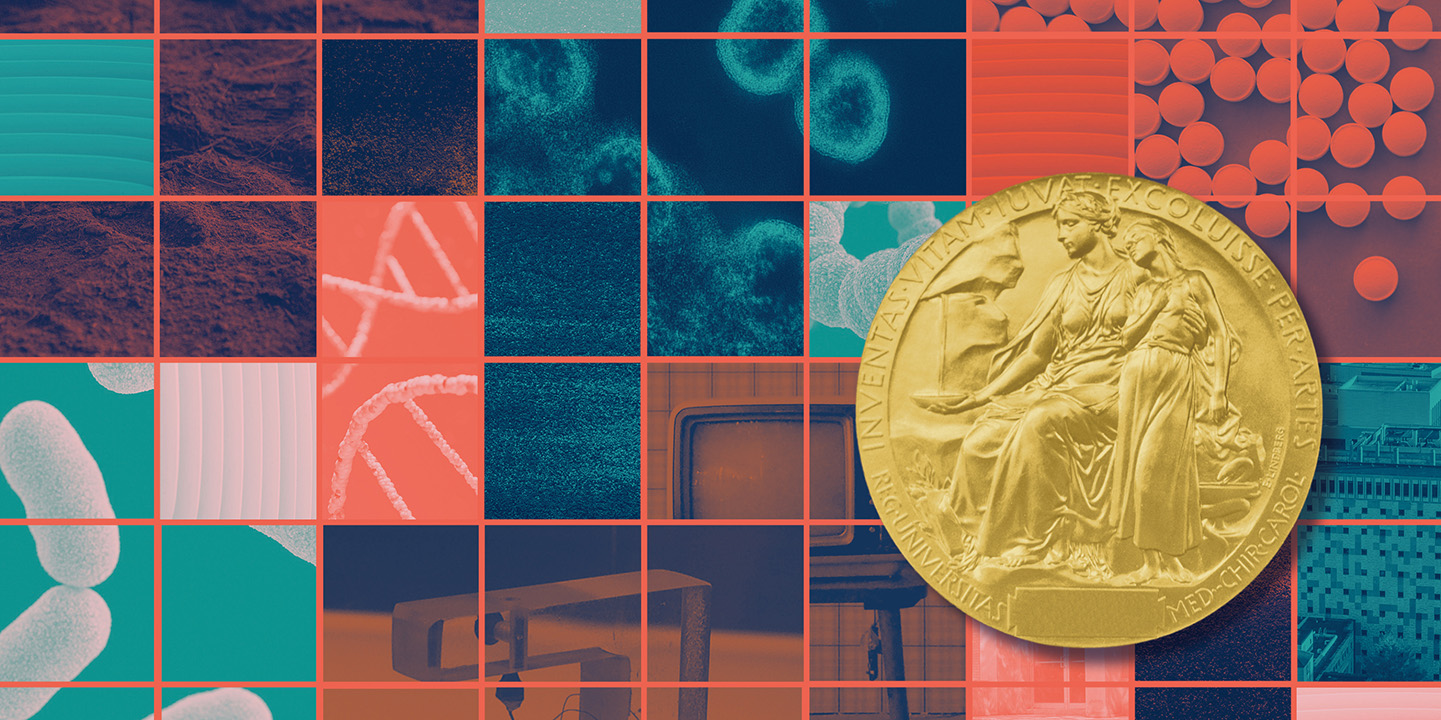
How to Win a Nobel Prize
Meet the UW–Madison faculty and alumni whose discoveries changed the world.
Science is a team sport. Every discovery is collaborative in nature, building on basic scientific research and the iterative contributions of untold scientists around the world.
Therefore, we do not envy those in Stockholm, Sweden, who must isolate all the variables and single out particular scientists for every Nobel Prize.
Nineteen scholars with UW–Madison ties have won a Nobel, including alumni and faculty members (past or present at the time of the award). This number places the UW in elite company — by most counts, among the top 20 universities in the country.
And still, it doesn’t seem enough for all the Nobel-worthy work that takes place on this campus.
Some observers were stunned when UW biologist James Thomson, who first derived human embryonic stem cells in the lab, was not among the stem cell scientists who shared in the 2012 Nobel Prize. That same year, the “God particle” Higgs boson was discovered with critical contributions from UW physicists Sau Lan Wu and Wesley Smith and computer scientist Miron Livny. But the following year, the Nobel Prize went to a pair of international researchers who had first theorized about Higgs’s existence. So it goes.
The UW’s last Nobel Prize winner came in 2015, when William Campbell MS’54, PhD’57 earned recognition for discovering a popular antiparasitic medication. Who will be next? We can’t say for sure, but sources tell us that several UW researchers remain in serious consideration for the world’s most prestigious award.
With federal research funding at risk here and elsewhere, it’s time to celebrate the Nobel-winning Badgers who — sometimes in dramatic fashion — made life-changing break-throughs for the benefit of us all.
A Heretic Turned Hero
Howard Temin had a hunch. It would lead the UW–Madison virologist to a Nobel Prize in 1975 and later contribute to the discovery of HIV. But first, it earned him the scorn of the scientific community.
Prior to 1970, the field of molecular biology operated on the central dogma that genetic information in cells is transferred in one direction — from DNA to RNA — to produce proteins. Never the other way. But closely studying the anomalies of a cancer-causing virus in chickens, Temin theorized in 1964 that some viruses — later classified as retroviruses — could reverse this process to spread.
For six years, this stance caused him ridicule. A former Cal Tech colleague gave a professional talk on these viruses without citing any of Temin’s seminal contributions. When pressed by the audience why not, the researcher responded: “I’ve given Temin’s work the amount of attention it deserves.”
Intellectually fearless, Temin never wavered. “All of these doubts were based not on experimentation or alternative hypotheses, but merely arguing from the central dogma that viruses don’t behave that way,” he later told the UW Oral History Project.
Then in 1970, Temin discovered the enzyme — reverse transcriptase — that does, in fact, allow genetic information to flow backward. When he went home that evening, his excitement was so palpable that his wife, renowned UW medical geneticist Rayla Greenberg Temin MS’58, PhD’63, knew instantly that he had proven his hunch right.
Practically overnight, he reflected, “I went from being a rebel to establishment.”
Temin’s discovery revolutionized molecular biology, opening doors to new areas of cancer research, drug development, and gene therapy applications. It also provided the roadmap for researchers to identify HIV, the retrovirus that causes AIDS, early in the epidemic and to eventually develop effective antiretroviral treatments. Temin played an active part in research and public policy efforts related to the AIDS crisis in the 1980s and early ’90s.
When he accepted his Nobel Prize, he proved again that he was not afraid to speak his mind. Toasting a banquet audience filled with cigarette smokers (including the king and queen of Sweden), Temin expressed “outrage” that, while his fellow researchers were tackling cancer in the lab, so little was being done to address a leading and preventable cause of it.
“And then I sat down,” Temin recalled, “and everyone in the audience, including the royalty, put out their cigarettes.” (In a cruel twist of fate, Temin died from a nonsmoking form of lung cancer in 1994 at age 59.)
Temin joined the UW’s McArdle Laboratory for Cancer Research in 1960 after finishing graduate school and a postdoc fellowship. He claimed that the center had reached out to “practically every young virologist, as many as 40 or 50, and none would come,” since, nationally, viruses were not viewed as a particularly important aspect of cancer research. We now know that viruses cause up to 20 percent of all cases.
When Temin arrived in Madison, he found his first lab to be unsuitably located in a dark basement surrounded by steam pipes and next to an open sump pit. From that inauspicious start, he went on to become a giant in his field and the UW’s only individual Nobel Prize winner to finish out his career at the institution. Upon being named a Nobel laureate, he thanked the university “for having provided … an environment in which unorthodox ideas could be considered and established.”
Cracking the Genetic Code
Har Gobind Khorana grew up in poverty in the small village of Raipur, India. His family home was partly a courtyard, shared with cows and horses. There was no schoolhouse, so the future Nobel laureate learned to read under a tree from his father. When Khorana, at age six, owned his first pencil, it was a life event.
“Although poor, my father was dedicated to educating his children, and we were practically the only literate family in the village inhabited by about 100 people,” Khorana wrote in an autobiographical entry for the Nobel Prize.
Eventually, Khorana attained formal education in India, proving himself a genius. In 1960, he came to the UW to be a professor of biochemistry and codirect the Institute for Enzyme Research. Here, he and his colleagues discovered how genes direct the production of proteins — groundbreaking work that cracked the genetic code and resulted in a 1968 Nobel Prize.
Khorana was the last of his family, including his kids, to learn of the award. Harking back his humble childhood, he often retreated to the Wisconsin countryside to collect his thoughts. Khorana was watching the sun rise when his wife, having failed to reach him several times by phone, drove over to relay the news.
In 1970, Khorana created the world’s first synthetic gene, demonstrating that the basic unit of heredity can be constructed with organic chemicals in a lab. His discoveries helped clear the way for modern gene therapy and genome editing, which have resulted in revolutionary treatments for those with severe genetic diseases.
Apparently, Khorana’s understated personality made him easy to miss in the public eye. In 1969, just a year after he had earned the Nobel Prize, Wisconsin state senator Ernest Keppler ’49, LLB’50 took to the chamber floor to lament that some public employees were making a higher salary than the governor. Referencing a list of names, he sneered: “How about Har Gobind Khorana? Any of you know him?”
MIT leadership certainly did, hiring Khorana away from Madison after a decade of work that changed the scientific world forever.
An Electronic Miracle
A quartet of UW alumni have earned Nobel Prizes for their work in supercharging the digital revolution and the many electronic devices in your home, at work, in your hand, and on your wrist.
John Van Vleck 1920, the “father of modern magnetism,” laid the foundation with his novel theories on the magnetic properties of solid-state materials. Alan MacDiarmid MS’52, PhD’53 discovered polymers (think plastics) that conduct electricity, with applications that now span from rechargeable batteries to electronic sensors to LED displays. Before creating the handheld calculator, Jack St. Clair Kilby MS’50 helped invent the integrated circuit, or microchip, an essential component of modern computers and the key to our miniaturized devices.
But only one Badger brainiac has won a pair of Nobel Prizes: John Bardeen ’28, MS’29.
Bardeen was born and raised in Madison, where his father served as the UW’s first medical school dean. He lived at home while studying electrical engineering at the university and enrolled in one of the first quantum theory courses in the country with Professor Van Vleck. He continued his graduate work at Princeton under Eugene Wigner, a theoretical physicist who would later work at the UW and earn a Nobel Prize himself.
Being surrounded by such brilliance paid off. After serving in World War II, Bardeen landed at Bell Labs and coinvented a semiconductor device called the transistor. Hailed as an electronic miracle, it replaced the much larger and less efficient vacuum tube that amplified early radios, televisions, and computers. (Today, an iPhone 15 Pro has some 19 billion transistors in its main processor alone.)
When Bardeen came back from the lab after his breakthrough on the transistor, he told his wife in his typically understated way: “I think we discovered something today.” The invention earned Bardeen and two colleagues the Nobel Prize in Physics in 1956.
At the Nobel Prize ceremony, the king of Sweden teased Bardeen for only bringing one of his three children. The scientist responded, presumably in jest, that he would bring all of them the next time he won a Nobel Prize.
Remarkably, 16 years later, that’s exactly what he did. He won his second prize for the fundamental theory of superconductivity (when electrical resistance vanishes below a certain temperature) — knowledge that is now applied in technologies such as the MRI scanner.
Bardeen is one of four laureates who have earned more than one Nobel Prize, and the only to double dip in the physics category.
Mr. and Mrs. Lederberg
It started as a picture-perfect story. The Wisconsin State Journal called the UW geneticists “one of the top husband-wife science teams in the nation” who “spend many more hours together in the laboratory than in their home.” And together they earned the 1956 Pasteur Award for their joint contributions to microbiology.
But in 1958, Joshua Lederberg won the Nobel Prize, while Esther Zimmer Lederberg PhD’50 was barely a footnote. In a famous picture of the couple from the ceremony, an expressionless Esther stares blankly ahead at the camera. Fittingly, she’s now the face of the Matilda Effect — a term coined by historian Margaret Rossiter MS’67 to describe the historical bias against recognizing the contributions of female scientists and instead attributing their findings to male colleagues.
Joshua Lederberg won the Nobel Prize at the young age of 33 for his field-altering discoveries around bacterial reproduction, producing an understanding of how traits like antibiotic resistance can spread. He was the UW’s first active faculty member to earn a Nobel Prize, sharing the honor with his mentor Edward Tatum MS’32, PhD’34.
Esther Lederberg met Joshua while she was finishing up her master’s degree at Stanford, and they both moved to Madison when he accepted a professorship at the UW in 1947. After earning her doctorate, she became a research associate in her husband’s lab. In a 1998 interview with the UW Oral History Project, Joshua called Esther a “superb” and “very meticulous experimentalist” who organized and executed many of the lab’s studies.
During this time, Esther discovered the lambda phage, a stealthy bacterial virus that could stay dormant in an infected host until suddenly striking. It’s become a go-to model organism in the study of other viruses and in the work of genetic engineering. She also helped to develop a modern research technique called replica plating — using velvet cloth to efficiently transfer colonies of bacteria from one dish to another. Until recent years, the scientific community had primarily attributed replica plating to Joshua.
During his Nobel Prize lecture, Joshua noted that his research “enjoyed the companionship of many colleagues, above all my wife.” But the award marked the start of their divergent careers. When Joshua was offered a position to lead the genetics department at Stanford in 1959, Esther had to settle for an untenured research faculty position there — and then fight to stay employed at all after the couple split in 1966.
“Esther, in her life, had to face a number of hurdles that had been placed in her way by the times,” her former colleague Stanley Falkow said at her memorial service in 2006. “She did so with extraordinary grace, gentleness, and with a respect and love for science that is important to remember and emulate, especially in a time when the pursuit of basic knowledge is becoming so very difficult.”
A Wonder Drug
Last January, the World Health Organization announced that Niger was the first African country to eliminate the transmission of river blindness. Before the 1980s, the disease — caused by a parasitic worm and spread from blackflies — became a public health crisis in developing nations and caused blindness in hundreds of thousands of people around the world. Now the disease is on a steep decline, thanks to the mass distribution of an antiparasitic medication called ivermectin — the wonder drug first discovered by UW alumnus William Campbell.
Campbell was a scientist at the pharmaceutical company Merck in the mid-1970s when he found that an active substance in a new species of soil bacteria was extraordinarily effective in killing roundworms in mice and other parasites in farm and domestic animals. A more potent derivative called ivermectin was released as an animal health product in 1981 and is a commonly used drug for heartworm prevention for dogs and cats today.
Not yet satisfied, Campbell advocated for potential human applications and identified river blindness as a promising target. Ivermectin was approved for human use in 1987, and since then Merck has donated some five billion doses to combat river blindness. The drug has also been used to treat scabies, head lice, and other tropical diseases such as elephantiasis — benefiting hundreds of millions of people, many in the poorest parts of the world. In 2015, Campbell shared a Nobel Prize for his heroic contributions.
Campbell grew up in Ireland and sailed to the U.S. for graduate work in veterinary science and zoology at the UW. He was hooked on parasites all the way back in high school, when an outing to an agricultural show introduced him to a common liver parasite in sheep and cattle. He was fascinated that a drug could so easily treat it.
His adviser at the UW, veterinary science professor Arlie Todd, encouraged Campbell to apply to Merck after earning his doctorate. At first, Campbell had “considerable misgiving” about starting off in the pharmaceutical industry.
“I only wanted to work on science for the sake of science and not for utility,” he said after earning a 2023 UW Distinguished Alumni Award, “but I discovered the tremendous joy and excitement of doing something that might actually be useful.”
UW Nobel Winners
How many Nobel Prizes can UW–Madison claim? It depends on how you’d like to count them.
Nineteen UW faculty and alumni have won a Nobel. Because John Bardeen won twice, the university can (and does!) use the nicely rounded number of 20 Nobel Prizes. But a pedant could point out that Edward Tatum and Joshua Lederberg shared in the same Nobel Prize in 1958, and the same for Joseph Erlanger and Herbert Gasser in 1944, bringing the UW’s number of distinct awards down to 18.
The UW has nearly added other future Nobel winners to its faculty. Milton Friedman, who helped establish the Chicago school of economics and won a 1976 Nobel Prize, briefly taught at the UW as a visiting scholar in the early 1940s. He withdrew his name for consideration as a tenured professor and left the economics department amid internal disputes. Richard Feynman was set to join the physics department in 1942, but the university discreetly granted him leave so that he could work on the government’s Manhattan Project. He won a Nobel Prize in 1965 for his theory of quantum electrodynamics. And George Smith, who worked at the UW as a postdoc in the 1970s, won the 2018 Nobel Prize in Chemistry for a technique in studying protein interactions.
The following list includes only UW faculty and alumni who were individually named for the prize. Professors Jonathan Patz and John Magnuson served as lead authors for the UN’s Intergovernmental Panel on Climate Change, which shared the 2007 Nobel Peace Prize with former Vice President Al Gore.
—P. S.
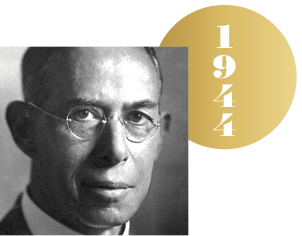
Physiology or Medicine
Joseph Erlanger
former faculty
for “discoveries relating to the highly differentiated functions of single nerve fibers” (1/2 prize share).
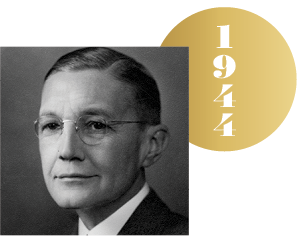
Physiology or Medicine
Herbert Gasser
1910
for “discoveries relating to the highly differentiated functions of single nerve fibers” (1/2 prize share).

Physics
John Bardeen
’28, MS’29
for “research on semiconductors” and “discovery of the transistor effect” (1956; 1/3 prize share); for the “jointly developed theory of superconductivity, usually called the BCS-theory” (1972; 1/3 prize share). Photo: Nobel Foundation
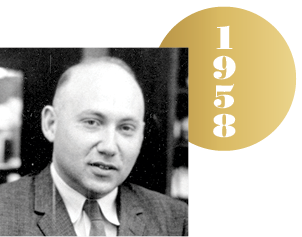
Physiology or Medicine
Joshua Lederberg
active faculty
for “discoveries concerning genetic recombination and the organization of the genetic material of bacteria” (1/2 prize share).
PHOTO: UW ARCHIVES
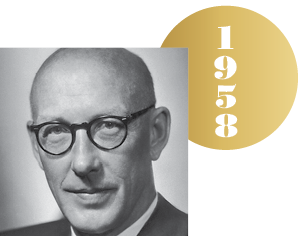
Physiology or Medicine
Edward Tatum
MS’32, PhD’34
for the “discovery that genes act by regulating definite chemical events” (1/4 prize share).
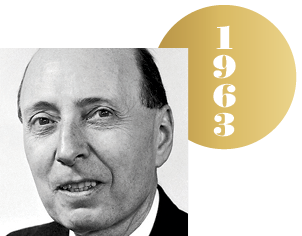
Physics
Eugene (E. P.) Wigner
former faculty
for “contributions to the theory of the atomic nucleus and the elementary particles, particularly through the discovery and application of fundamental symmetry principles” (1/2 prize share).

Physiology or Medicine
Har Gobind Khorana
active faculty
for the “interpretation of the genetic code and its function in protein synthesis” (1/3 prize share). PHOTO: UW ARCHIVES

Chemistry
Stanford Moore
PhD’38
for the “contribution to the understanding of the connection between chemical structure and catalytic activity of the active center of the ribonuclease molecule” (1/4 prize share). PHOTO: INGBERT GRÜTTNER (THE ROCKEFELLER UNIVERSITY DIGITAL COMMONS)
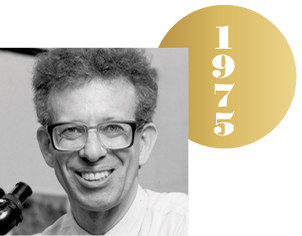
Physiology or Medicine
Howard Temin
active faculty
for “discoveries concerning the interaction between tumor viruses and the genetic material of the cell” (1/3 prize share).
PHOTO: UW ARCHIVES

Literature
Saul Bellow
MAx’38
for the “human understanding and subtle analysis of contemporary culture that are combined in his work.”
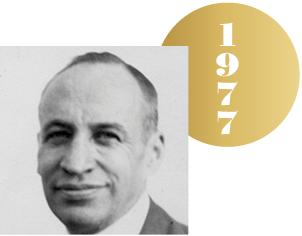
Physics
John Van Vleck
1920 + former faculty
for “fundamental theoretical investigations of the electronic structure of magnetic and disordered systems” (1/3 prize share).
PHOTO: UW ARCHIVES
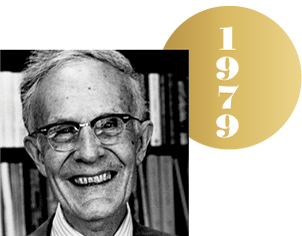
Economics
Theodore Schultz
MS’28, PhD’30
for “pioneering research into economic development research with particular consideration of the problems of developing countries” (1/2 prize share). UNIVERSITY OF CHICAGO PHOTOGRAPHIC ARCHIVE, APF1-07486 R, HANNA HOLBORN GRAY SPECIAL COLLECTIONS RESEARCH CENTER, UNIVERSITY OF CHICAGO LIBRARY.
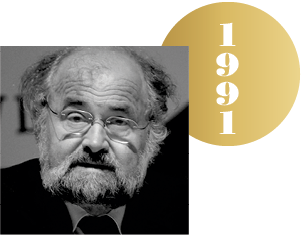
Physiology or Medicine
Erwin Neher
MS’67
for “discoveries concerning the function of single ion channels in cells” (1/2 prize share).
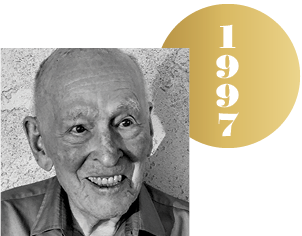
Chemistry
Paul Boyer
MS’41, PhD’43
for the “elucidation of the enzymatic mechanism underlying the synthesis of adenosine triphosphate (ATP)” (1/4 prize share). PHOTO: CREATIVE COMMONS ATTRIBUTION–SHARE ALIKE 4.0 INTERNATIONAL
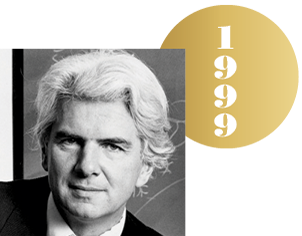
Physiology or Medicine
Günter Blobel
PhD’67
for the “discovery that proteins have intrinsic signals that govern their transport and localization in the cell.” PHOTO: INGBERT GRÜTTNER (THE ROCKEFELLER UNIVERSITY DIGITAL COMMONS)

Chemistry
Alan MacDiarmid
MS’52, PhD’53
for the “discovery and development of conductive polymers” (1/3 prize share). Photo: CREATIVE COMMONS ATTRIBUTION–SHARE ALIKE 3.0 UNPORTED
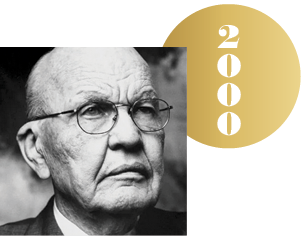
Physics
Jack St. Clair Kilby
MS’50
for “his part in the invention of the integrated circuit” (1/2 prize share). Photo: Nobel Foundation
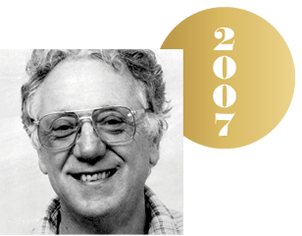
Physiology or Medicine
Oliver Smithies
former faculty
for “discoveries of principles for introducing specific gene modifications in mice by the use of embryonic stem cells” (1/3 prize share). PHOTO: UW ARCHIVES
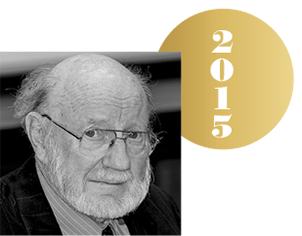
Physiology or Medicine
William Campbell
MS’54, PhD’57
for “discoveries concerning a novel therapy against infections caused by roundworm parasites” (1/4 prize share).PHOTO: CREATIVE COMMONS ATTRIBUTION-SHARE ALIKE 4.0 INTERNATIONAL
Preston Schmitt ’14 is a senior staff writer for On Wisconsin.
Published in the Winter 2025 issue

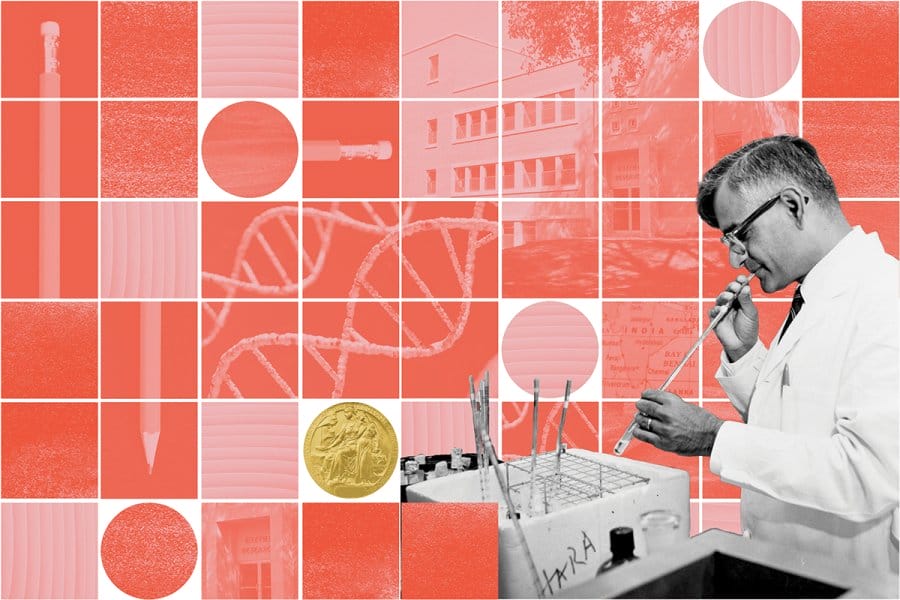
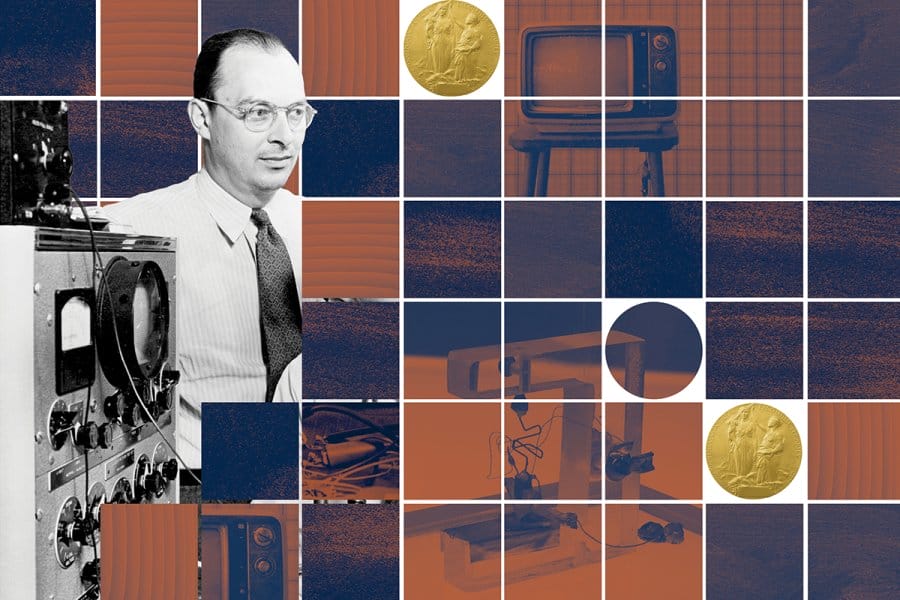

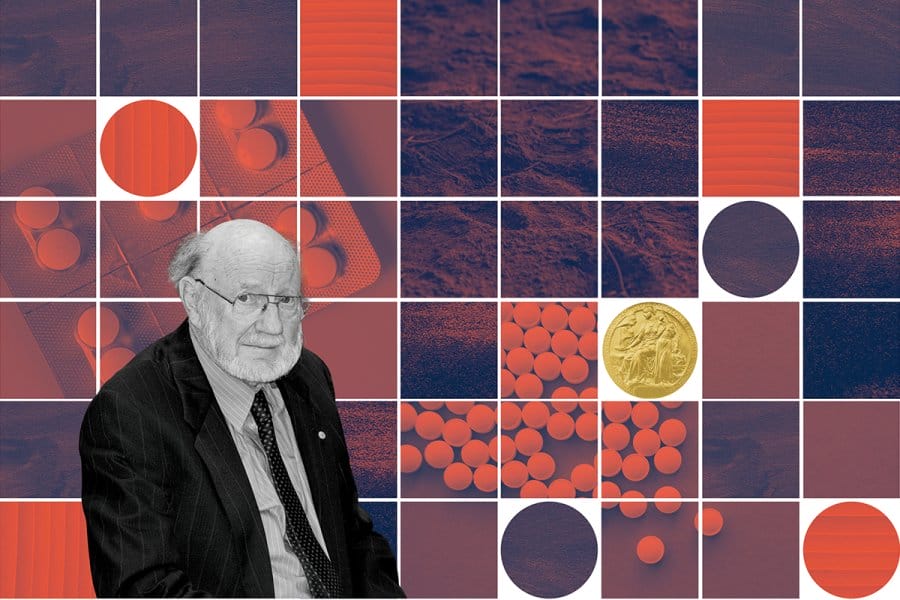
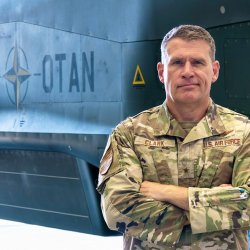
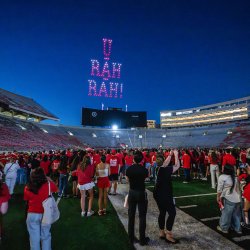

Comments
No comments posted yet.